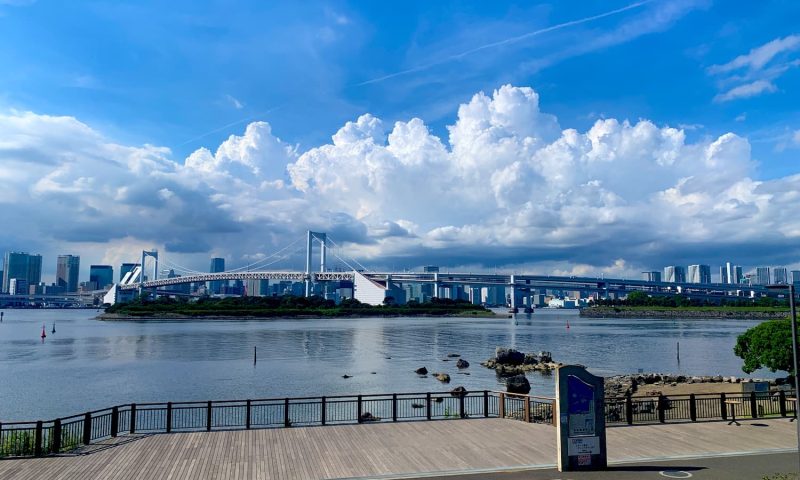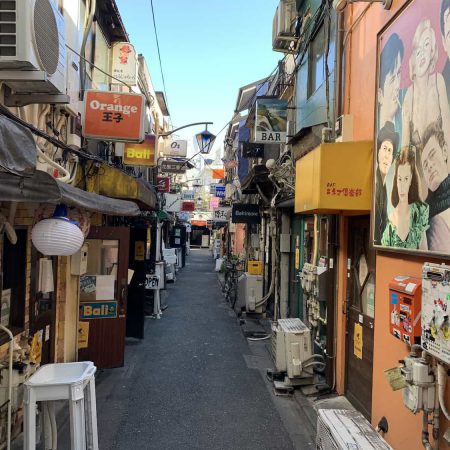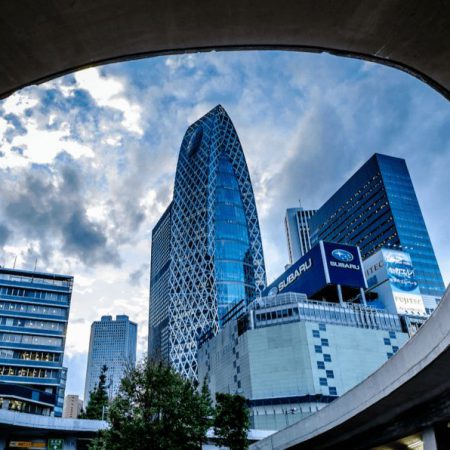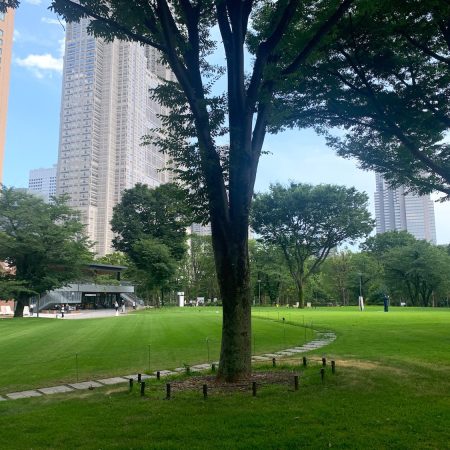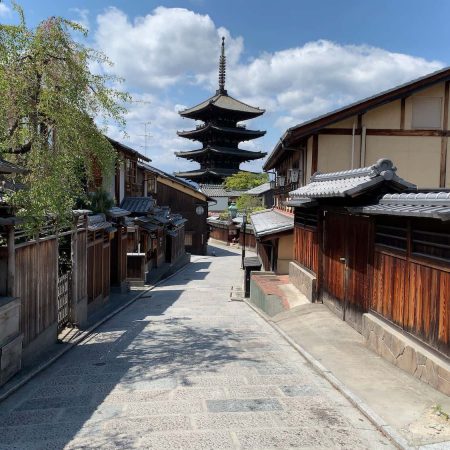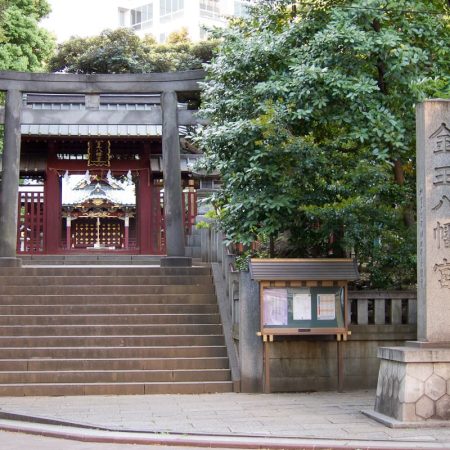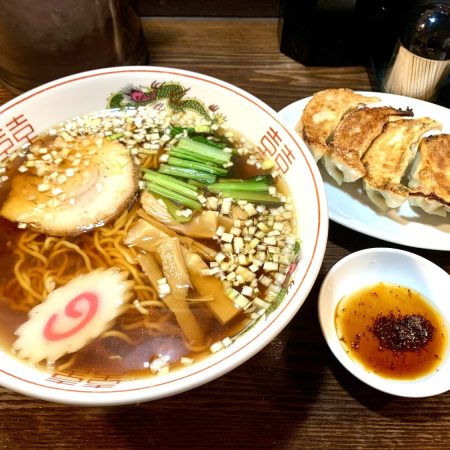Discover the vibrant heart of Tokyo’s Minato Ward at Roppongi Hills, where skyscrapers seamlessly blend with nature, showcasing iconic landmarks like the Mori Tower and captivating experiences such as the Keyakizaka Illumination. Adjacent to this, Mohri Garden offers a tranquil escape with traditional Edo-style designs and seasonal transformations. Enjoy panoramic vistas and cultural immersion at Tokyo City View, and find respite in the modern oasis of Midtown Garden in Akasaka. Experience artistic innovation at The National Art Center, and explore Japanese virtues at Atago Shrine atop Tokyo’s highest natural terrain, with nearby Shiba Park providing historic tranquility. Witness Tokyo’s evolving skyline at Azabudai Hills, and delve into the enchanting realm of Hayao Miyazaki at the NTV Clock, while admiring the engineering marvel of the Rainbow Bridge symbolizing Tokyo’s transformation and unity.
Roppongi Hills (六本木ヒルズ)
Discover Tokyo’s vibrant heart pulsating at Roppongi Hills, an urban masterpiece spanning 11 hectares. Crafted by the visionary Minoru Mori, this sprawling complex seamlessly integrates nature with architectural marvels, establishing a city within a city. Rise above the urban commotion at the iconic Roppongi Hills Mori Tower, towering at 238 meters. As dusk descends, ascend to the observation deck for a breathtaking panoramic vista of Tokyo’s skyline, featuring landmarks such as the Tokyo Tower and Skytree etched against the horizon.
Yet, Roppongi Hills transcends mere skyscrapers. Experience the enchantment of Keyakizaka Illumination during winter, as the streets metamorphose into a mesmerizing light spectacle, spanning 400 meters. Delve into a realm of culture and creativity at the Mori Art Museum, which showcases contemporary art from Japan and beyond. Simultaneously, Tokyo City View offers an unparalleled perspective of the cityscape, inviting visitors to immerse themselves in Tokyo’s artistic essence.
Events like Roppongi Art Night and Craft Sake Week infuse the area with fresh energy, providing myriad opportunities for exploration and discovery. With its seamless transportation links, including multiple subway lines and bus routes, navigating this modern wonderland is effortless. More than a commercial hub, Roppongi Hills epitomizes Japan’s contemporary society, fostering dialogue and exchange between local talent and the global community. Embrace innovation, culture, and convenience in this dynamic urban oasis.
Mohri Garden (毛利庭園)
In the heart of bustling Roppongi Hills, a hidden oasis awaits – the enchanting Mohri Garden. Tucked away amidst the urban jungle, this traditional Edo-style stroll garden is a sanctuary of serenity amidst the city’s lively pulse.
Surrounded by the towering giants of Roppongi Hills Mori Tower and the majestic TV Asahi building, Mohri Garden stands as a testament to both history and tranquility. Amidst the concrete skyscrapers, it offers a haven where visitors can escape the rush and embrace a moment of peace.
As the seasons change, so does the garden’s charm. In winter, it transforms into a mesmerizing wonderland adorned with dazzling illuminations, casting a spell of magic over its visitors.
Renowned for its proximity to Television Asahi, Mohri Garden has become a national treasure, often gracing the screens of news broadcasts. Spanning a vast 4,300 square meters, this Japanese-style haven invites guests to wander through its paths and lose themselves in the beauty of nature.
The gentle murmur of the waterfall, the babbling stream, and the meandering river create a symphony of tranquility, offering a soothing soundtrack to accompany one’s stroll. And with each passing season, from the delicate bloom of cherry blossoms to the radiant gold of ginkgo leaves, the garden unveils a new chapter of natural splendor.
In a city where every corner tells a story of modernity, Mohri Garden stands as a timeless testament to Japan’s rich heritage, inviting all who enter to pause, breathe, and embrace the beauty of simplicity.
Tokyo City View (六本木ヒルズ展望台 東京シティビュー)
Ready to elevate your Tokyo experience? Tokyo City View offers an unparalleled adventure in the heart of Japan’s metropolis. Enter Roppongi Hills Mori Tower and marvel at the city’s beauty from 270 meters above sea level.
Ascend to the Sky Deck, Tokyo’s crown jewel, and indulge in panoramic views of the urban landscape. Venture into the Sky Gallery, where art and culture converge, showcasing Tokyo’s landmarks and glimpses of Mt. Fuji. Explore from every perspective, join yoga classes, or attend exclusive events like the “Heatherwick Studio: Building Soulfulness” exhibition.
Tokyo City View isn’t just an observation deck; it’s a celebration of Japanese culture and innovation. On the 52nd floor, enjoy a 360-degree panorama, while the Mori Art Museum on the 53rd floor invites exploration of contemporary art. Access is easy via Roppongi Station.
Don’t miss this chance to witness Tokyo’s skyline. Whether you’re a traveler or art enthusiast, Tokyo City View awaits your discovery. Head there today for an unforgettable urban adventure.
Midtown Garden (ミッドタウンガーデン)
Tucked away in the heart of Akasaka, amid Tokyo’s lively streets, lies a secret haven – the Midtown Garden. Stretching across a sprawling 40,000 square meters, this urban sanctuary offers a serene escape for tired souls craving tranquility. And the best part? It’s absolutely free, welcoming visitors around the clock, seven days a week.
Crafted by the visionary team at EDAW in San Francisco, the Midtown Garden seamlessly melds modern architecture with timeless Japanese design principles. Step into its four distinct zones, each a masterpiece of vibrant greenery and enchanting water features. Whether you find yourself wandering the Highland Spring Zone or lingering in the captivating Forest Edge Zone, each vista promises a new delight.
Yet, what truly sets the Midtown Garden apart is its ever-changing charm. Spring brings forth a symphony of cherry blossoms, while autumn dresses the landscape in fiery hues of red, orange, and yellow. And when winter descends, the garden transforms into a magical wonderland, aglow with captivating light displays.
But there’s more to this sanctuary than meets the eye. It serves as a living tribute to Japanese culture, echoing centuries-old traditions and philosophies. Every element, from tranquil ponds to graceful pavilions, whispers tales of harmony between humanity and nature.
For bird enthusiasts, the Midtown Garden is a paradise found. Home to approximately 25 bird species year-round, it offers a delightful glimpse into Tokyo’s diverse avian life. Grab a charming bird handbook, complete with illustrations and species characteristics, for a deeper connection with nature.
Yet, the Midtown Garden isn’t just for seekers of serenity. Throughout the year, it plays host to a vibrant tapestry of events and activities. From cherry blossom festivals to captivating art installations, concerts, and workshops, there’s always something intriguing to discover at this open-air art museum.
So whether you’re in search of solace or craving a cultural immersion like no other, the Midtown Garden beckons, ready to enchant and inspire all who venture through its gates.
The National Art Center, Tokyo (国立新美術館)
The National Art Center, Tokyo (NACT) stands as a beacon of artistic innovation in Tokyo, offering a unique museum experience. Designed to ignite exploration and discovery, NACT’s 14,000 square meter exhibition space, crafted by architect Kisho Kurokawa, hosts 12 galleries showcasing diverse artistic expressions.
Set in the bustling cultural hub of Tokyo, NACT fosters mutual understanding and cultural exchange. Its dedication to accessibility, with free admission and convenient locations near Nogizaka Station and Roppongi Station, sets it apart. NACT liberates visitors from static displays, inviting dynamic engagement with art through evolving exhibitions and interactive experiences.
NACT’s Art Library provides a wealth of art-related information, ensuring accessibility and engagement for all. Innovative technology, including a smartphone app and dynamic digital signage, enhances the visitor experience, seamlessly integrating art and technology.
From pioneering movements to avant-garde fashion, NACT’s exhibitions span genres and eras, showcasing global artistry. Recognized for its architectural brilliance and cultural significance, NACT draws millions of visitors annually, affirming its status as a premier art destination in Tokyo. Welcome to the National Art Center, Tokyo—where art transcends boundaries and inspiration knows no limits.
Stairway of Success (愛宕神社 出世の石段)
Perched atop Tokyo’s highest natural terrain mountain in the bustling 23 wards lies Atago Shrine, a hidden gem established in 1603 by shogun Tokugawa Ieyasu. More than a mere architectural marvel, it serves as a guardian, shielding Tokyo from calamity and embodying Japanese virtues liake courage and perseverance.
At the shrine’s core are the legendary “Stone Steps to Success,” 86 steps boasting a daring slope angle of 37 degrees. These steps, tied to tales of social ascent and career success, hold mystical significance, especially in the year of the horse according to the Chinese zodiac.
Beyond material pursuits, Atago Shrine represents a harmonious balance between nature and urbanization, nestled amidst towering skyscrapers. Visitors can choose between the challenging “Man Hillside” or the gentler “Woman Hillside,” or opt for the discreetly tucked elevator.
Upon reaching the summit, visitors are immersed in Japan’s rich cultural heritage, from traditional dances to ancient music, particularly during the annual Stone Steps Festival in September. Amidst Tokyo’s urban sprawl, Atago Shrine stands as a beacon of tradition and progress, inviting all to embrace the Japanese spirit of resilience and pursuit of excellence.
Shiba Park (芝公園)
Nestled in Tokyo’s Minato district, Shiba Park is a historic oasis dating back to 1873. It’s renowned for its natural beauty and cultural significance, boasting towering camphor, zelkova, and ginkgo trees that create a tranquil atmosphere.
The park’s highlights include the Shiba Maruyama tomb, spanning 110 meters and showcasing Japan’s ancient legacy. During autumn, the man-made Autumn Leaf Valley transforms the landscape with stunning gold and red hues.
Visitors shouldn’t miss the Shiba Toshogu Shrine, a masterpiece of architecture built in 1644, and Zojo-ji temple, dating back to 1393, housing the tombs of six Tokugawa shoguns.
Adjacent to the park is Tokyo Tower, offering panoramic views of the city and housing various attractions. Shiba Park seamlessly blends tradition with modernity, offering something for every visitor, whether seeking nature’s serenity or cultural exploration.
Azabudai Hills (麻布台ヒルズ)
Azabudai Hills is a transformative landmark in Tokyo’s bustling heart, reshaping the skyline and urban living. Completed in 2019 and unveiled on November 24, 2023, this visionary project by Mori Building spans 8.1 hectares, boasting a towering height of 325.19 meters and seamlessly integrating offices, residences, medical facilities, commercial spaces, and an international school.
Residence B and Residence A, towering at heights of 262.83 meters and 237.20 meters respectively, epitomize the essence of a “Modern Urban Village,” blending lush greenery with contemporary design for a serene urban oasis.
Step into the Azabu Daihills Garden Plaza for a tranquil escape amidst the city’s hustle, where verdant surroundings reshape Tokyo into a sustainable metropolis. Ascend to the 33rd-floor observatory for panoramic views of iconic landmarks like Tokyo Tower, Roppongi Hills, and Odaiba, with Mount Fuji gracing the horizon on clear days.
Beyond its concrete facade, Azabudai Hills embodies urban elegance, seamlessly blending innovation with tradition and harmonizing the cityscape with nature. Mori Building invites you to experience this unparalleled lifestyle, where sophistication, tranquility, and Tokyo’s vibrant energy converge. Welcome to Azabudai Hills, where the future meets the present, and urban living reaches new heights of elegance.
Hayao Miyazaki’s NTV Clock (宮崎駿の日テレ時計塔)
Step into the captivating realm of Hayao Miyazaki, the visionary mastermind behind Studio Ghibli, where enchantment and creativity merge to unveil marvels beyond imagination. Amidst the vibrant streets of Tokyo rises a spectacle unparalleled – the Ghibli Clock.
Conceived from the depths of Miyazaki’s limitless imagination, this monumental timepiece transcends the conventional concept of a clock; it embodies the epitome of craftsmanship and artistic ingenuity. Over six meticulous years, skilled artisans painstakingly fashioned 1228 copper plates, transforming them into a breathtaking sculpture weighing a remarkable 28 tons.
Enter this towering masterpiece and prepare to embark on a voyage through time and fantasy. Spanning 18 meters in width, 12 meters in height, and 3 meters in depth, the Ghibli Clock exudes magnificence, beckoning guests to immerse themselves in its mesmerizing splendor.
Inspired by Miyazaki’s iconic masterpiece “Howl’s Moving Castle,” the clock’s design emanates a spirit of whimsy and adventure. Its exterior, reminiscent of a fantastical fortress, stands resolute, as if poised to journey into uncharted realms, capturing the essence of the beloved anime classic.
Miyazaki envisioned the Ghibli Clock as more than a mere monument; it was intended to be embraced by the people of Tokyo, a symbol of wonder and delight. Even today, throngs gather to witness its enchanting movements, as intricate gears set the clock in motion, weaving a captivating spectacle that mesmerizes all who behold it.
Beyond its utilitarian function as a timepiece, the Ghibli Clock stands as a testament to Miyazaki’s enduring legacy – a true masterpiece that continues to evoke awe and kindle the imagination of all who encounter its enchantment.
Rainbow Bridge (レインボーブリッジ)
Visualize Tokyo, a city teeming with vitality, where the fusion of modernity and tradition permeates every corner. Situated in the heart of this dynamic metropolis stands a destination not to be missed—the Rainbow Bridge. Spanning an impressive 800 meters over the Tokyo Bay, this feat of engineering and design seamlessly links the bustling city center to the Rinkai Fukutoshin area.
However, there is more to the Rainbow Bridge than initially meets the eye. As the sun sets below the horizon, the Rainbow Bridge undergoes a breathtaking transformation. Envision 444 luminous lights adorning its expanse, gracefully transitioning between three distinct hues. This captivating array of colors transforms the Tokyo Bay into an enchanting spectacle, captivating all who behold it.
Furthermore, the allure of the bridge transcends its radiant exterior. Featuring two decks catering to both vehicular and pedestrian traffic, the Rainbow Bridge offers an unparalleled experience. The upper tier facilitates the smooth flow of four lanes of bustling vehicles, while the lower tier accommodates the Yurikamome rapid transit system, Tokyo Prefectural Route 482, and inviting pedestrian walkways. Fondly known as the “South Route” and “North Route,” these walkways stretch over 1.7 kilometers, treating visitors to panoramic views of Tokyo’s skyline—a haven for photographers indeed.
Herein lies the highlight—it’s all complimentary! Whether by day or night, residents and visitors alike can traverse the Rainbow Bridge’s walkways, immersing themselves in its grandeur. As night falls, the bridge springs to life with a captivating light display that changes with the seasons and special occasions. From vibrant hues of red and green during Christmas to delicate shades of pink during cherry blossom season, each illumination enhances Tokyo’s skyline with a touch of magic.
Yet, beyond its aesthetic appeal, the Rainbow Bridge carries profound significance. It serves as a testament to Tokyo’s transformation from a humble fishing village to a global powerhouse. Symbolizing resilience and unity, the bridge connects diverse cultures and communities, weaving together the tapestry of Tokyo’s rich history and heritage.
Therefore, as you leisurely stroll along the Rainbow Bridge’s promenade, taking in the panoramic vistas, pause for a moment to absorb it all. For beneath its steel and concrete lies a narrative—a tale of innovation, beauty, and the essence of Tokyo itself.

